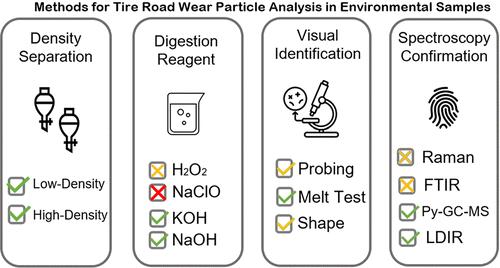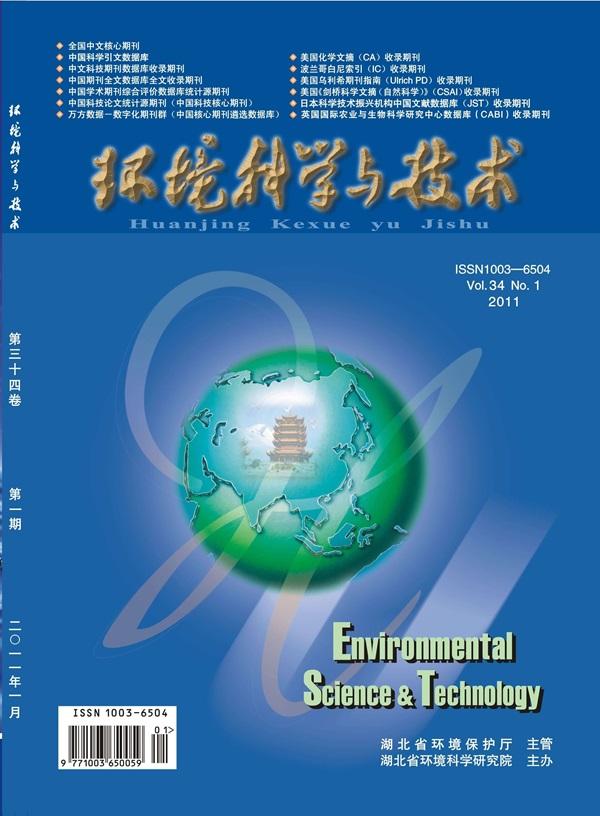Adapting Methods for Isolation and Enumeration of Microplastics to Quantify Tire Road Wear Particles with Confirmation by Pyrolysis GC–MS
IF 10.8
1区 环境科学与生态学
Q1 ENGINEERING, ENVIRONMENTAL
引用次数: 0
Abstract
The complex, varied composition (i.e., rubbers/elastomers, carbon black, fillers, additives, and embedded road materials) and wide density range of tire road wear particles (TRWPs) present challenges for their isolation and identification from environmental matrices. Reliable quantification is important for understanding the environmental fate and potential adverse effects of TRWPs. To address environmental monitoring needs, the present work adapts a series of isolation and identification steps from methods commonly applied for microplastic analysis for single-particle-level enumeration of TRWPs from environmental samples. We present the method performance of a two-stage density separation with saturated NaCl and sodium polytungstate to isolate TRWPs from sediment matrices, the compatibility of tire microrubber with reagents used for digestion of environmental matrices, and the use of elasticity and heat resistance observations to differentiate TRWPs from bitumen particulates, which are potential visual interference. We found that alkaline digestions (NaOH and KOH) are compatible with tire microrubbers, but hydrogen peroxide and sodium hypochlorite can cause TRWPs to lose elasticity and flatten or break when probed. The adapted methods were applied to road dust samples, and a subset of identified TRWPs was qualitatively confirmed by both scanning electron microscopy and pyrolysis-gas chromatography–mass spectrometry. Further, a compilation of aspect ratio measurements of TRWPs between 63 and 500 μm (N = 780) that were isolated from urban sediments shows the potential diversity of TRWP shapes in the environment.

采用微塑料分离枚举方法定量轮胎路面磨损颗粒,并采用热解气相色谱-质谱法进行验证
轮胎路面磨损颗粒(TRWPs)的成分复杂多样(即橡胶/弹性体、炭黑、填料、添加剂和嵌入的道路材料),密度范围广,对其从环境基质中分离和识别提出了挑战。可靠的量化对于了解trwp的环境命运和潜在的不利影响非常重要。为了满足环境监测的需要,本工作采用了一系列分离和鉴定步骤,这些步骤来自于通常用于微塑料分析的方法,用于从环境样品中单颗粒水平枚举TRWPs。我们介绍了饱和NaCl和多钨酸钠两阶段密度分离从沉积物基质中分离TRWPs的方法性能,轮胎微橡胶与用于消化环境基质的试剂的相容性,以及使用弹性和耐热性观察将TRWPs与沥青颗粒区分开来,这是潜在的视觉干扰。我们发现碱性消化(NaOH和KOH)与轮胎微橡胶兼容,但过氧化氢和次氯酸钠会导致trwp失去弹性,在探测时变平或断裂。将该方法应用于道路粉尘样品,并通过扫描电子显微镜和热解-气相色谱-质谱法对鉴定出的一部分TRWPs进行了定性确认。此外,从城市沉积物中分离出的63 ~ 500 μm (N = 780)之间的TRWP的纵横比测量结果汇编显示了环境中TRWP形状的潜在多样性。
本文章由计算机程序翻译,如有差异,请以英文原文为准。
求助全文
约1分钟内获得全文
求助全文
来源期刊

环境科学与技术
环境科学-工程:环境
CiteScore
17.50
自引率
9.60%
发文量
12359
审稿时长
2.8 months
期刊介绍:
Environmental Science & Technology (ES&T) is a co-sponsored academic and technical magazine by the Hubei Provincial Environmental Protection Bureau and the Hubei Provincial Academy of Environmental Sciences.
Environmental Science & Technology (ES&T) holds the status of Chinese core journals, scientific papers source journals of China, Chinese Science Citation Database source journals, and Chinese Academic Journal Comprehensive Evaluation Database source journals. This publication focuses on the academic field of environmental protection, featuring articles related to environmental protection and technical advancements.
 求助内容:
求助内容: 应助结果提醒方式:
应助结果提醒方式:


